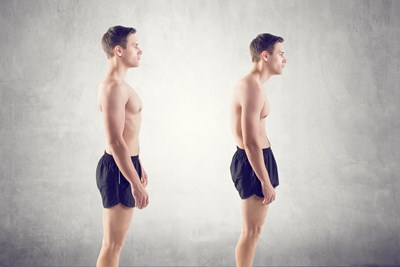Scoliosis is a lateral curvature in the normally straight vertical line of the spine. The spine shows a mild curve in the upper back and an inward curve in the lower back. When viewed from the front or back, the spine can look like an "S" or a "C". Approximately 2% to 3% of Americans by age sixteen have scoliosis. Less than 0.1% have spinal curves measuring greater than forty degrees, which is the point when surgery is considered. It occurs most often during the growth spurt just before puberty. While scoliosis can be cause by conditions such as cerebral palsy and muscular dystrophy, most scoliosis causes are unknown. Most cases are mild, but severe scoliosis can be disabling. An especially severe spinal curve can reduce the amount of space within the chest, making it difficult for the lungs to function properly. Children who have mild scoliosis are monitored closely with X-rays to see if the curve is worsening. Scoliosis is diagnosed by exam with a physician, who will check to see if a child's back or ribs are even. If the doctor finds that one side is higher than the other, the child may need an X-ray for final confirmation.
Scoliosis Causes
There are many types and causes of scoliosis, however most cases are Idiopathic, meaning the specific cause is unknown. Many theories exist, but none have been conclusive. Strong evidence supports the idea that idiopathic scoliosis is inherited. There are three classifications of scoliosis. Congenital scoliosis is caused by a bone abnormality present at birth. Neuromuscular scoliosis is a result of abnormal muscles or nerves. This is common in those with spina bifida or cerebral palsy, or in those with various conditions that are accompanied by, or cause, paralysis. Degenerative scoliosis may result from traumatic bone collapse due to injury or illness, previous major back surgery, or osteoporosis (a thinning of the bones). Having one leg that is longer than the other also may cause a curvature of the spine that develops into scoliosis. Scoliosis secondary to neuromuscular disease may develop during adolescence, such as with tethered spinal cord syndrome. Experimental testing is being done to determine if blood test can reveal whether or not scoliosis will worsen in a given individual. Fifty-three genetic markers have been identified, and scoliosis has been described as a biomechanical deformity. This type of testing is likely to be more common in the future.
Risk Factors of Scoliosis Causes
The risk factors of scoliosis causes, for the most common type, include the following. Age is a main risk factor. Signs and symptoms typically appear during the growth spurt occurring just before puberty. Another risk factor is a child's sex. Although both boys and girls develop mild scoliosis at about the same rate, girls have a much higher risk of progression and the curve worsening, which will then require scoliosis treatment. The evidence is building that scoliosis can be genetic, and it tends to run in families. If one of the bones in a child's spine has moved forward, out of place, compared to the rest of the spine, he or she is at greater risk of scoliosis. A child whose arms or legs are missing or abnormally short is at greater risk, as are children who has other complications with tissue growth that happened before birth. As with most conditions, early detection goes a long way in reducing the risks and progression of scoliosis. Undetected, progressed scoliosis puts an individual at great risk for three-dimensional curvature and the need for spinal fusion surgery and can also put the child in danger of other complications to the rest of the body.



